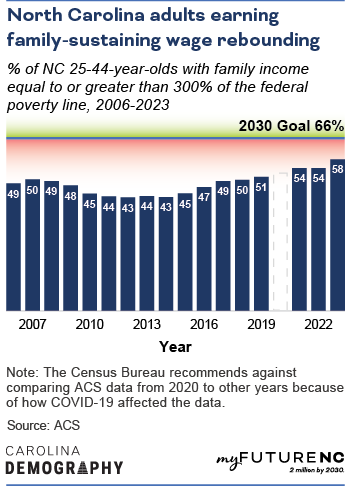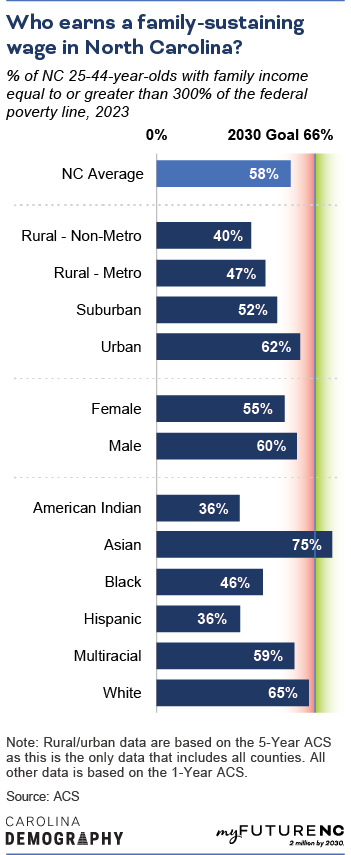Percentage of working North Carolina residents aged 25-44 earning a living wage
Last updated: 2023
= Top southern state :
only available for totals, not available for all indicators
What does Family-Sustaining-Wage mean?
Percent of North Carolina 25-44-year-olds earning a living wage. A living wage is defined as earning a family income equivalent to 300% or more of the federal poverty line.
What does this data show?
More than half—58%—of North Carolina’s prime working age adults (25-44) had a family income equal to or greater than 300% of the federal poverty line in 2023. In 2023, a single adult with no children living in North Carolina would need to earn an annual income of at least $35,012 to meet this threshold. In Virginia, the top-performing southern state, the proportion of 25-44-year-olds earning a family-sustaining wage was 66%. In Texas and Georgia—two southern states with similar costs of living to North Carolina—the share of adults earning a family-sustaining wage in 2023 was comparable to our state: 57% in both Georgia and Texas. On average, southern states have lower living wage values than other states while the poverty line is the same value everywhere in the United States. This means that 300% of the federal poverty line means something very different in North Carolina than it does in New York or California.
By 2030, the goal is to have 66% of North Carolina residents, ages 25-44 earning a family-sustaining wage (>=300% of the federal poverty line).
Why does Family-Sustaining-Wage matter?
A family-sustaining or “living wage” is defined by the MIT Living Wage Calculator as earning enough to cover necessary expenses—such as food, medical care, childcare, housing, and transportation—without having to rely on financial assistance from other sources.
An increase in the percent of North Carolina 25-44-year-olds earning a living wage may indicate:
- An increase in the availability of high-quality jobs that pay family-sustaining wages.
- That more individuals and their families have the economic resources they need to weather day-to-day struggles without relying on external supports.
How is North Carolina performing?
Meeting the 2030 Goal
North Carolina needs 236,077 more 25-44-year-olds earning a family-sustaining wage to meet the statewide goal.
 The share of North Carolina adults ages 25-44 earning a family-sustaining wage peaked in 2023 at 58%. This proportion held steady around 50% until 2010 reaching a low point of 43% in 2012 and 2014. Since 2015 the proportion has steadily increased, reaching a high of 58% in 2023.
The share of North Carolina adults ages 25-44 earning a family-sustaining wage peaked in 2023 at 58%. This proportion held steady around 50% until 2010 reaching a low point of 43% in 2012 and 2014. Since 2015 the proportion has steadily increased, reaching a high of 58% in 2023.
By geography
Across North Carolina, the likelihood of being in a family that earns a family-sustaining income varies by geography and is lower for those residing in more rural areas. More than half of urban (62%) and suburban (52%) residents earn a family-sustaining wage compared to 47% of rural-metropolitan county residents and 40% of non-metropolitan rural county residents. These differences reflect both county-level differences in the cost of living and differences in the types of jobs available in these counties.
By sex
Men are more likely to have a family-sustaining wage (60%) than women (55%).

By race/ethnicity
Three out of four Asian residents earn a family-sustaining wage (75%). This share is more than six in ten among White residents (65%). Almost six in ten Multiracial 25-44-year-olds earned a family-sustaining wage in 2023 (59%), higher than rates among Black adults (46%). Our state’s Hispanic residents and American Indian residents were least likely to earn a family-sustaining wage: 36% of adults in both racial/ethnic groups earned family-sustaining wages in 2023.
Methodology
Where does the data for family-sustaining wage come from?
A family-sustaining wage or living wage is the income needed for a family to cover minimum necessary expenses, such as food, childcare, healthcare, housing, and transportation, in a given area. The Massachusetts Institute of Technology’s (MIT) Living Wage Calculator provides data on the hourly living wages for states, metropolitan areas, and counties. The MIT Living Wage Calculator values have been adjusted to reflect family size, household composition, number of earners, and local cost of living. This model assumes that all working adults in the household are employed full time (2,080 hours per year) and does not account for non-essential purchases or savings and investments.
In 2023, family-sustaining wages in North Carolina range from $16.83 per hour for one working adult living alone to $42.45 per hour for one working adult supporting three children. When compared to poverty wages—the hourly wages associated with the poverty threshold set by the U.S. Department of Health and Human Services—the living wage values for North Carolina are between 200% to 300% of the poverty wage, depending on family type. Across all family types, the average living wage rate is 240% of the poverty wage. Based on these calculations—and the suggestion from MIT that their wages be considered a “minimum subsistence wage”— we use 300% of the federal poverty line as the threshold for family-sustaining wage to ensure our calculations reflect a minimum living wage standard regardless of family structure.
Detailed data on family income is from the U.S. Census Bureau’s American Community Survey (ACS). This annual survey of demographic, economic, and social characteristics has been collected for all households and group quarters populations since 2006. The Public Use Microdata Series (PUMS) contains anonymized person-level observations that enable custom tabulations of the data for the state and some counties. Data for all counties is available in the 5-Year ACS in Table B17024: Age by Ratio of Income to Poverty Level in the Past 12 Months.
How was the data calculated?
Carolina Demography calculated the family-sustaining wage rate using ACS PUMS data retrieved from IPUMS-USA. Individuals were identified as earning a family-sustaining wage if they had a family income at or above 300% of the federal poverty line.
The family-sustaining wage rate was calculated by dividing the estimated number of adults ages 25-44 with family incomes above 300% of the federal poverty line by the total number of adults ages 25-44 for whom the poverty status was determined.

Who is included?
All residents of North Carolina ages 25-44 for whom the poverty rate can be calculated.
Who isn’t included?
The Census Bureau excludes certain groups from poverty calculations, such as residents of college dormitories or military barracks. Full details on the poverty universe are available here.
Certain types of group quarters facilities are not sampled in the ACS due to difficulties associated with data collection, such as domestic violence shelters, soup kitchens, and living quarters for victims of natural disasters. Full details on the ACS sample and methodology are available here.
The data used in the development of this indicator is derived from a survey and is subject to sampling and non-sampling error.
Learn more
Who is working on this in NC?
Help improve this section
If you know of an organization that is working on this topic in NC, please let us know on the feedback form.
NC-focused, state-level dashboards
Name: NC Chamber Dashboard
Website: https://ncchamber.com/dashboard/
About: The NC Chamber Dashboard informs dialogue and catalyzes action to address North Carolina’s economic development challenges and opportunities. It provides independent and objective data on leading indicators in four critical areas important for state and business competitiveness.
Name: NC Workforce Development Board Dashboard
Website: https://bi.nc.gov/t/COM-LEAD/views/NorthCarolinaWDBDashboard/ImpactsSummary
About: This tool displays information on the services rendered, participants served, and outcomes achieved through the state’s Workforce Development Boards.
Name: NC Labor Supply/Demand Analyzer
Website: https://nccareers.org/s-d/
About: Developed by the NC Department of Commerce, this tool tracks the tightness of the state’s labor market and view estimates of the number of jobseekers and job openings.
Name: NC Works Labor Market Indicator Dashboard
About: Find Labor Market Information Data such as occupation information, wage information, unemployment rates, advertised job posting statistics, demographic information, and more.
FAQ
How does a family-living wage differ from the minimum wage?
From MIT Living Wage calculator: “The state minimum wage is the same for all individuals, regardless of how many dependents they may have.” In contrast, the living wage is the hourly rate “an individual in a household must earn to support his or herself and their family.”
How much money does it take to earn above 300% of the federal poverty line?
The federal poverty line (also known as the poverty threshold) varies by household size, age, and number of children. For example, a single adult under age 65 needed to earn $47,550 in 203 to earn three times the poverty line. A family of four, meanwhile, needed to earn $93,600 to have a family income greater than 300% of the federal poverty line.



